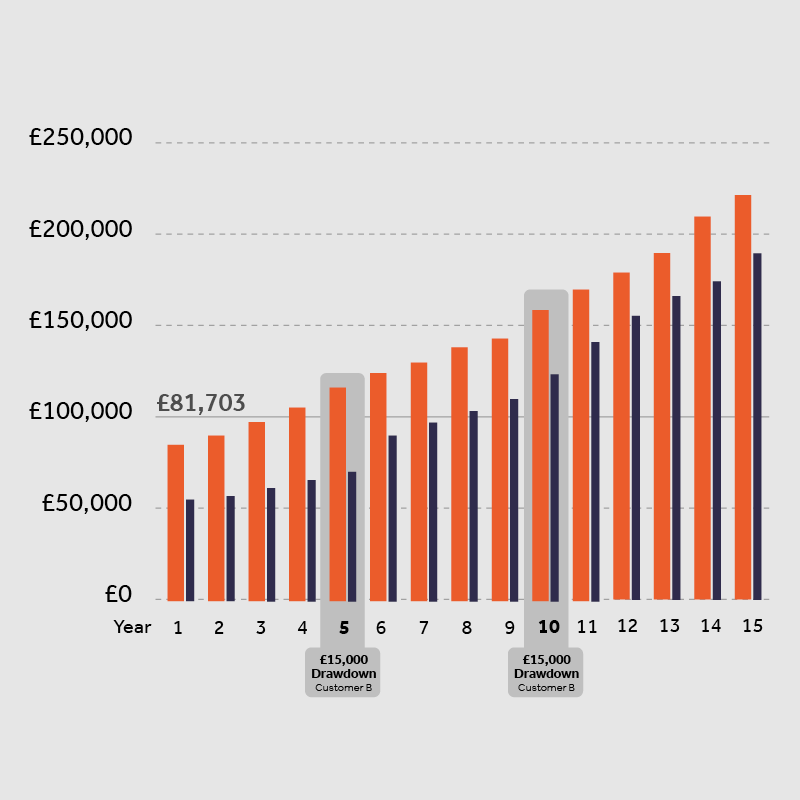We use some essential cookies to make our website work properly.
We’d also like to set additional cookies to help us improve our website, tailor marketing and provide a more personal experience.
A drawdown lifetime mortgage is a type of lifetime mortgage that allows you to access some of the equity in your home over time.
Instead of taking a single lump sum, you start with an initial release and then access smaller amounts as needed. This makes it a flexible option for managing your retirement finances.
With a drawdown equity release plan, interest is only charged on the money you’ve released, not the total amount available to you. This can significantly reduce the amount of interest you’ll pay over the lifetime of the loan.
A drawdown lifetime mortgage works by allowing you to release funds gradually while staying in your home. By allowing you to release funds as you need them, following an initial release.
With a drawdown lifetime mortgage, a total borrowing limit is agreed when you take out the plan. You’ll receive an initial lump sum and can make additional withdrawals as required, subject to criteria.
Here are some key features of a drawdown lifetime mortgage:
A drawdown lifetime mortgage provides flexibility to access funds for a variety of needs. Some common uses include:
Paying off your existing mortgage
Gifting to family members
Funding home improvements
Repaying existing debts
ⓘ Be financially aware: You should always think carefully before securing a loan against your home to repay existing debt.
The alternative to a drawdown lifetime mortgage is a lump sum lifetime mortgage. A lump sum lifetime mortgage allows you to receive your tax-free funds all in one go. It could be ideal for gifting the money to a family member for a deposit on a new home.
There are benefits and drawbacks of both lump sum lifetime mortgages and drawdown lifetime mortgages. With Key, we can help you decide which option best suits your needs.
Benefits of a lump sum lifetime mortgage
Lump sum plans could offer lower interest rates, reducing borrowing costs.
Drawbacks of a lump sum lifetime mortgage
Additional funds require a further advance application, this would require advice and be subject to fees and lender approval.
Benefits of a drawdown lifetime mortgage:
Offers more freedom than a lump sum plan, allowing you to release money when you need it.
Interest accrues only on the funds you release, saving you money over time.
Drawbacks of a drawdown lifetime mortgage
Your drawdown facility isn't guaranteed. Your lender has the option to withdraw your drawdown facility.
Drawdowns are subject to prevailing fixed interest rates, which may be higher or lower than your original rate.
You could save thousands over the course of your plan with a drawdown lifetime mortgage. This is because you only pay interest on the funds you release. Here's an example to help you understand how this could work for you.
ⓘ Illustrative example
This example is for illustrative purposes only. There are two customers with access to a lifetime mortgage facility of £81,703 at an interest rate of 6.74%, this is over 15 years but it could be longer or shorter. Future drawdowns are subject to the prevailing interest rate. Key Market Monitor Q1, 2023.

Customer A: Takes £81,703 in one go through a lump sum lifetime mortgage. Interest is charged on the full release amount from day one.
Customer B: Takes an initial loan of £51,703 to meet their immediate requirements. Interest is only charged on this lower release amount. They then decide to make two further £15,000 drawdowns over time, this makes their total release amount £81,703.
Customer B saves thousands in interest:
While Customer B still borrows the same £81,703 over 15 years, their total cost of borrowing is lower as interest is only charged when they release their funds. As a result, Customer B saves almost £32,851 in interest charges over the total life of their plan.
There are different types of lifetime mortgages which help thousands of UK homeowners take control of their later life finances. Here are some useful links to see if a lifetime mortgage could be right for you:
For more information on your later life options, read our free, comprehensive guide today.
Your other options with Key
Key offers alternatives to equity release such as a retirement interest-only mortgage or retirement repayment mortgage. If another product is more suitable, including home reversion, we'll refer you to a different specialist adviser within Key Group who can help. If you go ahead, you'll never be charged more than our fixed advice fee of £1,699, even if their fee is higher.
Other options to think about
It's important to know your other options before going ahead with equity release. These include: downsizing, unsecured lending, using existing assets, or support from friends or family.
Key is a specialist, award-winning later life mortgage provider for the over 55s. We've helped over a million customers see if equity release was right for them. After we take the time to understand your needs, we'll recommend the right later life option for you.
We're here to help
Our friendly equity release team is available: Mon-Thurs 9am-8pm, Fri 9am-5pm, Sat 9am-1pm, Sun closed.
Call free on 0808 252 9170 or book a call and we'll get in touch with you.